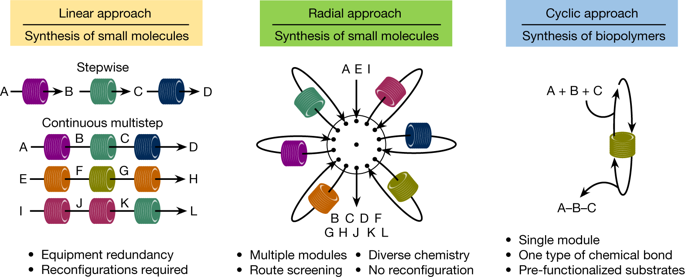Nature ( IF 50.5 ) Pub Date : 2020-03-18 , DOI: 10.1038/s41586-020-2083-5 Sourav Chatterjee 1 , Mara Guidi 1, 2 , Peter H Seeberger 1, 2 , Kerry Gilmore 1

|
Automated synthesis platforms accelerate and simplify the preparation of molecules by removing the physical barriers to organic synthesis. This provides unrestricted access to biopolymers and small molecules via reproducible and directly comparable chemical processes. Current automated multistep syntheses rely on either iterative1,2,3,4 or linear processes5,6,7,8,9, and require compromises in terms of versatility and the use of equipment. Here we report an approach towards the automated synthesis of small molecules, based on a series of continuous flow modules that are radially arranged around a central switching station. Using this approach, concise volumes can be exposed to any reaction conditions required for a desired transformation. Sequential, non-simultaneous reactions can be combined to perform multistep processes, enabling the use of variable flow rates, reuse of reactors under different conditions, and the storage of intermediates. This fully automated instrument is capable of both linear and convergent syntheses and does not require manual reconfiguration between different processes. The capabilities of this approach are demonstrated by performing optimizations and multistep syntheses of targets, varying concentrations via inline dilutions, exploring several strategies for the multistep synthesis of the anticonvulsant drug rufinamide10, synthesizing eighteen compounds of two derivative libraries that are prepared using different reaction pathways and chemistries, and using the same reagents to perform metallaphotoredox carbon–nitrogen cross-couplings11 in a photochemical module—all without instrument reconfiguration.
中文翻译:

有机分子的自动径向合成
自动化合成平台通过消除有机合成的物理障碍来加速和简化分子的制备。这通过可重复和直接可比的化学过程提供了对生物聚合物和小分子的无限制访问。当前的自动化多步合成依赖于迭代1、2、3、4或线性过程5、6、7、8、9,并且需要在多功能性和设备使用方面做出妥协。在这里,我们报告了一种自动合成小分子的方法,该方法基于一系列围绕中央开关站呈放射状排列的连续流动模块。使用这种方法,可以将简洁的体积暴露于所需转化所需的任何反应条件。顺序的、非同时的反应可以结合起来进行多步过程,从而能够使用可变流速、在不同条件下重复使用反应器以及储存中间体。这种全自动仪器能够进行线性和收敛合成,并且不需要在不同过程之间进行手动重新配置。这种方法的能力通过对目标进行优化和多步合成来证明,如图 10 所示,合成了使用不同反应途径和化学方法制备的两个衍生库的 18 种化合物,并使用相同的试剂在光化学模块中进行金属光氧化还原碳-氮交叉偶联11——所有这些都无需重新配置仪器。











































 京公网安备 11010802027423号
京公网安备 11010802027423号